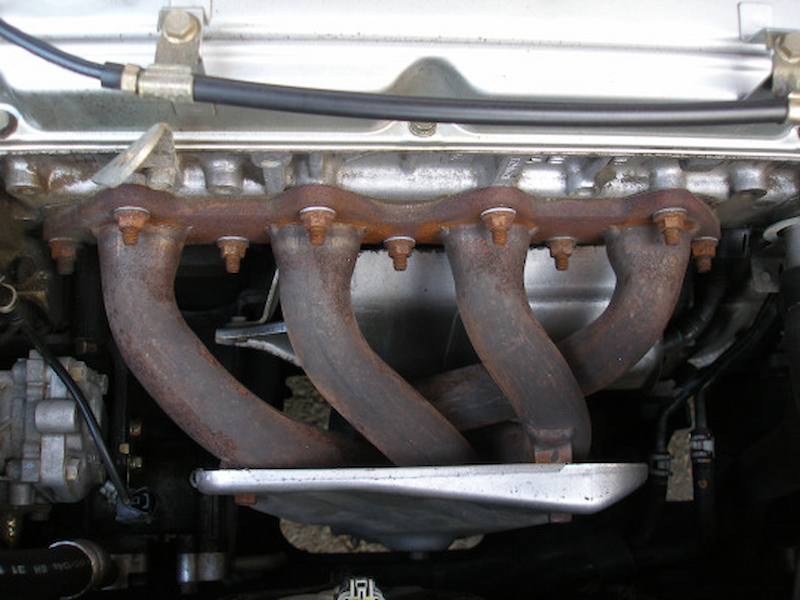We all know how important the exhaust system is for our cars. It’s the only system that handles engine fumes in more than one way. An exhaust helps direct them out of the engine and filter the fumes from any harmful pollutants. Although this may sound simple, it isn’t that straightforward.
Thanks to different components such as the oxygen sensor, catalytic converter, muffler, resonator and gaskets, an exhaust is able to stay intact while handling a high flow of gasses with ease. An exhaust also affects performance, efficiency and how your car sounds. This is all thanks to the proper management of those gasses which enter through the manifold or header as people also call it.
Exhaust Manifold

What is it?
Some would say that this component is more part of the engine than the exhaust but it’s actually part of both. It’s connected to the cylinders in the engine with each cylinder having a pipe that bends and goes down into the exhaust. The exhaust manifold is able to withstand high pressure and heat which is why they are one of the most important exhaust components.
How Does it Work?
Car manifolds collect engine fumes from each cylinder and they send it either to the catalytic converter or turbocharger. This depends on the type of engine your car has as turbo engines make use of those fumes and reintroduce them back into the cylinders at a certain RPM range. The reason why manifolds are curved is to direct the flow towards either the cat or turbo.
Types of Exhaust Manifolds

Cast vs Tubular
There are two types of manifolds when it comes to their design. You have cast exhaust manifolds which are one whole piece that is cast into a shape that helps collect engine gasses. Cast manifolds are affordable but they are not good for fuel economy as they can create interference between cylinders. Tubular manifolds are made of individual pipes which help solve the interference that cast manifolds have. This is also why tubular manifolds come made of different materials and in different patterns – more on that later.
Short vs Long
When it comes to the length of car manifolds it’s rather simple as there are long and short ones. Short tube manifolds are used in smaller cars where space under the bonnet isn’t plenty. They also scavenge gasses from the cylinders equally which helps create consistent power. Long tube manifolds have long primary tubes which is why they are found in racing cars as the length helps reduce back pressure and make for a wider power range.
4-2-1 vs 4-1
When it comes to their layout, manifolds usually come as either 4-2-1 or 4-1. A 4-2-1 layout is essentially a header that has 4 pipes that merge into 2 runners which are then merged into one pipe. This means it offers good mid-range power which is why this layout is most commonly used in 4 and 8-cylinder engines. A 4-1 layout is made so that all 4 pipes merge straight into one pipe. This makes for better top-end power and less backpressure than a 4-2-1 layout.
Manifold Materials
Cast Iron
The most affordable manifolds are made of cast iron as this material is reasonably priced and it can last for quite some time as it’s durable. Cast iron manifolds for sale also absorb heat quite well but they can crack more easily if you push your car to the limit.
Stainless Steel
If you want to go for a less brittle solution then stainless steel is a better option as it’s not only more durable but also a corrosion-resistant solution. Although stainless steel manifolds can turn blue this effect doesn’t affect their structural integrity. You can also buy a stainless steel manifold with a ceramic coating if you have a performance car.
Titanium
Talking about performance, titanium car manifolds are the best when it comes to racing applications. They are the lightest and also the strongest while being corrosion-resistant. One downside is that titanium manifolds are quite expensive.
When to Replace a Manifold

Fuel Economy
Manifolds are not indestructible no matter the material they’re made of and one of the first signs that you need a new one has to do with fuel economy. While poor fuel economy may not always be because of a faulty header, one could easily lead to such an issue. Make sure that you’ve clearly identified the issue before replacing the part.
Noise
Cracker or leaking manifolds will cause all sorts of noises to be present when driving but the most common one will be tapping or knocking noises when cracks do appear. Hissing sounds will be present if a header is leaking and they will get louder when you accelerate. If ignored, these two issues can become detrimental.
Odour
When you open the bonnet you will get an exhaust smell if the header is failing. This smell is not only a fire hazard but it also affects the lifespan of certain components such as wire insulation, plastic parts and metal gaskets close to the header.
Power
Loss of power is also going to be a distinctive indicator of a cracked header. This is usually noticeable especially at higher RPM as there is more stress being put on the engine and header. In this case, the scavenging role of the header will not happen and thus the loss of power occurs as a result.
